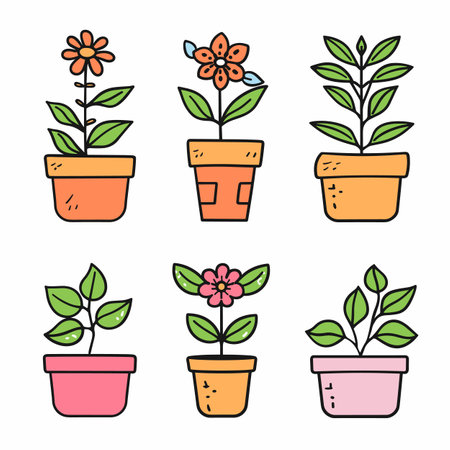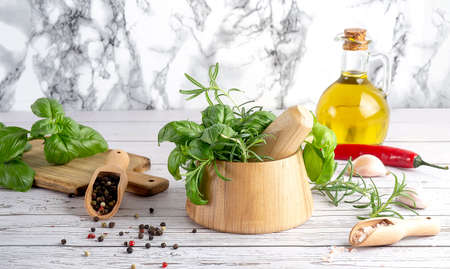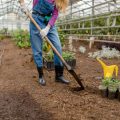1. Why Grow an Indoor Herb Garden?
If you love cooking and want to bring more flavor to your meals, starting an indoor herb garden is a great idea. Its not just a trendy hobby—its a practical and rewarding way to always have fresh herbs on hand. Whether you live in a small apartment or a house with limited outdoor space, growing herbs indoors makes it easy to enjoy fresh ingredients all year long.
Convenience at Your Fingertips
Imagine needing just a pinch of basil or a few sprigs of thyme while cooking, and all you have to do is snip them from your kitchen windowsill. No need to run to the store or worry about herbs going bad in the fridge. With an indoor herb garden, your favorite flavors are just steps away whenever you need them.
Save Money Over Time
Fresh herbs from the grocery store can be pricey—and they often spoil quickly. Growing your own herbs at home can save you money in the long run. Once your plants are established, they keep producing, giving you an ongoing supply without repeated trips to the store.
Enhance Your Cooking with Fresh Flavors
Fresh herbs add a burst of flavor that dried versions just can’t match. Whether youre tossing together a salad, making pasta, or grilling meat, having access to freshly harvested herbs can elevate every dish. Plus, experimenting with different herbs encourages creativity in the kitchen.
Year-Round Growing Potential
One of the best parts of indoor gardening is that its not limited by weather or seasons. Even during the winter months when outdoor gardens are dormant, your indoor herbs can continue to thrive with proper care and lighting.
Quick Look: Benefits of Indoor Herb Gardening
| Benefit | Description |
|---|---|
| Convenience | Easy access to fresh herbs right in your kitchen |
| Cost-Effective | Saves money over time compared to buying packaged herbs |
| Flavor Boost | Adds bold, fresh taste to meals |
| Year-Round Harvesting | No need to wait for spring—grow anytime indoors |
| A Fun Hobby | A relaxing and satisfying way to connect with nature at home |
Starting an indoor herb garden is one of the easiest ways to make your home more flavorful and functional. Whether youre new to gardening or already have a green thumb, growing culinary herbs indoors is a deliciously smart move.
2. Choosing the Right Herbs for Your Kitchen
When starting your indoor herb garden, selecting the right herbs is key to creating a flavorful and practical addition to your cooking space. Some herbs are easier to grow indoors than others, and many common culinary herbs thrive well in pots on a sunny windowsill or under grow lights.
Top Culinary Herbs That Grow Well Indoors
The following herbs are not only popular in American kitchens but also well-suited for indoor gardening. Whether youre seasoning pasta, roasting meats, or preparing fresh salads, these herbs will bring freshness and depth of flavor to your meals.
| Herb | Flavor Profile | Common Uses | Indoor Growing Tips |
|---|---|---|---|
| Basil | Sweet, slightly peppery | Pasta dishes, pesto, pizza, salads | Needs plenty of sunlight (6+ hours); keep soil moist but not soggy |
| Thyme | Earthy, slightly minty | Roasted meats, soups, stews, vegetables | Tolerates lower light; don’t overwater; prefers well-drained soil |
| Parsley | Mild, fresh, slightly bitter | Garnishes, sauces, soups, tabbouleh | Prefers moderate light; keep soil evenly moist; harvest regularly to promote growth |
| Rosemary | Pine-like, strong aroma | Lamb dishes, roasted potatoes, breads | Loves bright light; allow soil to dry between watering; avoid humidity buildup |
Consider Your Cooking Style
Think about the types of dishes you cook most often. If you love Italian cuisine, basil and oregano might be staples. If you lean toward hearty American comfort food, thyme and rosemary could be your go-tos. Starting with a few versatile herbs ensures you’ll actually use what you grow.
Other Herbs Worth Considering:
- Cilantro: Great for Mexican and Asian recipes like tacos and curries.
- Mint: Ideal for teas, desserts, and cocktails like mojitos.
- Dill: Perfect for pickles, fish dishes, and creamy dressings.
- Sage: Adds depth to stuffing, sausages, and roasted poultry.
Tip:
If youre short on space or new to gardening, start with two or three herbs that you use regularly. This way youll enjoy fresh flavors without feeling overwhelmed.

3. Setting Up Your Indoor Herb Garden
If youre a food lover who wants fresh herbs at your fingertips, setting up an indoor herb garden is a fun and rewarding project. With just a few essentials and the right setup, you can enjoy homegrown flavor year-round—no backyard required!
Lighting: Let There Be (Grow) Light
Most herbs love sunlight, needing around 6–8 hours of light each day. A sunny windowsill that faces south or southwest is ideal. If natural light is limited, don’t worry—a simple LED grow light will do the trick and keep your herbs thriving even in darker spaces.
Best Herbs for Low-Light and High-Light Areas
| Light Level | Herbs That Thrive |
|---|---|
| Bright Light (South-facing window or grow lights) | Basil, Rosemary, Oregano, Thyme |
| Moderate to Low Light (East/West-facing window) | Mint, Parsley, Chives, Cilantro |
Containers: Pick the Right Pots
Choosing the right container helps prevent root rot and promotes healthy growth. Use pots with drainage holes to allow excess water to escape. Clay or terracotta pots are great because they breathe, but plastic containers work well too and are lighter to move around.
Container Tips:
- Avoid overly large containers—they hold more water and can lead to soggy roots.
- Use saucers under pots to protect windowsills or countertops from moisture damage.
- If using decorative outer pots without drainage, place your herb in a smaller pot inside it (“pot-in-pot” method).
Soil: Not Just Dirt!
Use a high-quality potting mix designed for indoor plants. Avoid outdoor garden soil—it’s too dense and may carry pests. For herbs, a well-draining mix with added perlite or vermiculite keeps roots happy and healthy.
Recommended Soil Mix Ingredients:
- Organic potting soil base
- Coconut coir or peat moss for moisture retention
- Perlite or sand for drainage
- A small amount of compost for nutrients (optional)
Placement: Location Matters
Your herbs need access to good light and air circulation. Place them near a kitchen window where you can easily snip leaves while cooking. Make sure the area isn’t too drafty in winter or too hot in summer—herbs like consistency just like we do!
Quick Placement Checklist:
- Sunlight: 6–8 hours daily (natural or artificial)
- Airflow: Good ventilation prevents mildew and pests
- Avoid: Direct contact with cold glass in winter or heat vents in summer
- Convenience: Keep herbs close to where you cook to encourage use!
With the right setup—including proper lighting, containers, soil, and placement—you’ll be well on your way to growing fresh, flavorful herbs indoors all year long.
4. Everyday Care and Maintenance
Keeping your indoor herb garden thriving doesnt have to be complicated. With a few simple habits, you can enjoy fresh, aromatic herbs all year round. Heres how to keep your herbs healthy and full of flavor with regular care.
Watering Wisely
Overwatering is one of the most common mistakes with indoor herbs. Most herbs prefer slightly dry soil over soggy roots. A good rule of thumb is to water when the top inch of soil feels dry to the touch. Use pots with drainage holes to prevent root rot.
Watering Guide for Common Herbs
| Herb | Watering Frequency | Soil Preference |
|---|---|---|
| Basil | Every 2–3 days | Moist but well-draining |
| Thyme | Once a week | Dry, sandy soil |
| Mint | Every 2–3 days | Damp, rich soil |
| Rosemary | Every 5–7 days | Well-drained, slightly dry soil |
| Parsley | Every 2–3 days | Moist, fertile soil |
Pruning for Growth and Flavor
Regular pruning not only keeps your herbs looking neat but also encourages bushier growth and better flavor. Always use clean scissors or garden shears and cut just above a leaf node (where leaves grow from the stem). Avoid harvesting more than one-third of the plant at a time.
Quick Pruning Tips:
- Basil: Pinch off flower buds early to keep flavor strong.
- Cilantro: Trim weekly to delay bolting (going to seed).
- Mint: Cut back aggressively—it grows fast!
Pest Prevention Indoors
Pests like aphids, spider mites, and fungus gnats can still find their way indoors. Keep an eye out for yellowing leaves, sticky residue, or tiny webs. The best defense is early detection and natural treatments.
Natural Pest Control Options:
- Neem oil spray: Safe for edible plants, great for soft-bodied pests.
- Diluted dish soap spray: Mix a few drops with water and mist affected areas.
- Avoid overcrowding: Good airflow helps prevent pest buildup.
A Little Daily Attention Goes a Long Way
If you spend just a few minutes each day checking moisture levels, trimming as needed, and inspecting for pests, your herbs will reward you with vibrant growth and incredible taste—right from your kitchen counter or windowsill.
5. Harvesting and Using Your Herbs
Knowing the right time and method to harvest your herbs can make all the difference in flavor. Indoor herb gardens let you enjoy fresh ingredients year-round, but timing is key when it comes to picking them for cooking. Here’s how to get the most out of your homegrown herbs.
When to Harvest for Best Flavor
The best time to harvest herbs is just before they flower, when their essential oils are at their peak. Morning hours, after the dew has dried but before the sun gets too hot, are ideal for harvesting.
| Herb | When to Harvest | Signs Its Ready |
|---|---|---|
| Basil | Before flowering | Leaves are full-sized and fragrant |
| Mint | Early morning, before bloom | Vibrant green leaves, strong scent |
| Parsley | Once stems have three segments | Leaf clusters look full and healthy |
| Thyme | Just before blooming | Tender sprigs with strong aroma |
| Cilantro | Younger leaves, early growth stage | Bright green with flat, delicate leaves |
How to Harvest Without Harming the Plant
Use clean scissors or garden shears to snip herbs just above a leaf node (where leaves grow from the stem). This encourages new growth. Never take more than one-third of the plant at once—this keeps your herb healthy and productive.
Creative Ways to Use Fresh Herbs in Your Cooking
Basil: More Than Just for Pesto
Add fresh basil to caprese salads, tomato sauces, or even fruit smoothies for a sweet-savory twist.
Mint: Cool and Refreshing
Muddle mint into iced tea or mojitos, mix into yogurt sauces, or sprinkle over watermelon for a fresh summer snack.
Cilantro: A Zesty Kick
Perfect for tacos, salsas, and Asian stir-fries. Chop it up right before serving to keep its bold flavor intact.
Parsley: The Underrated Garnish
Add chopped parsley to roasted vegetables, pasta dishes, or use as a base for chimichurri sauce.
Thyme: Earthy and Aromatic
This herb pairs well with roasted meats, potatoes, and savory stews. Strip the tiny leaves from the stem before cooking.
Storing Leftover Herbs
If you have more than you can use fresh, store herbs by freezing them in olive oil using ice cube trays or drying small bunches upside down in a cool spot. This way, you’ll have flavorful additions ready anytime you cook.
An indoor herb garden brings both beauty and functionality into your kitchen space. With just a little care in harvesting and creativity in cooking, your favorite dishes will burst with homegrown freshness!


